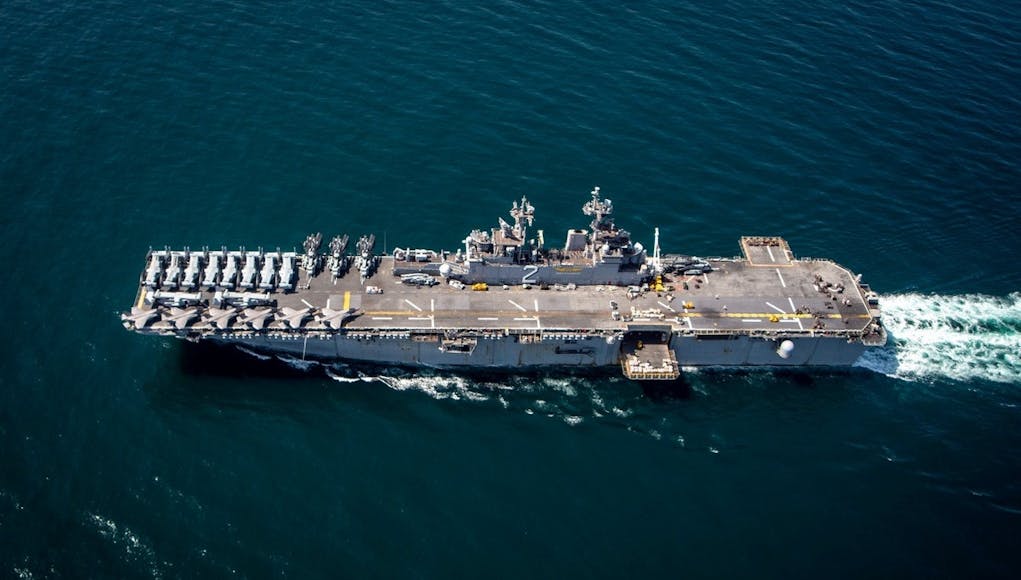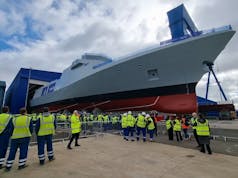On the 27th of September 2018, a United States Marines Corps F-35B was used against a Taliban target in Afghanistan, the first combat operation the type has been involved in.
The F-35B took off from the USS Essex amphibious assault ship in the Arabian Sea.
The US Marines confirmed the strike in a statement: “During this mission the F-35B conducted an air strike in support of ground clearance operations, and the strike was deemed successful by the ground force commander.”
The US Marine Corps declared the F-35B operational in 2015. The us Air Force followed by declaring initial operational capability for the F-35A 2016, while the US Navy plans to declare IOC on the F-35C in February 2019. For the UK, IOC will be this year from land and 2020 from sea.
The F-35 programme has gone through serious teething problems, problems also experienced by the majority of complex aircraft flying today such as the F-15, Typhoon or any other modern combat jet.
The biggest issue for the project continues to be the fact it is the most expensive military weapons system in history owing to the sheer scope of the programme but that being said, aircraft costs are now coming down and will soon be similar to the cost of many aircraft it’s replacing.
Today the programme is maturing rapidly, right now much of the activity around the jet is dealing with software bugs and testing to validate the software, with most of the physical testing being to do with weapons integration and the gradual scaling up of capabilities that comes with each new software block.














Nice to see. It obviously wasn’t necessary to use an F-35 here as I’m sure there were other assets in the area, but its the best way to test sensors etc. in a real world environment and I’m sure a lot was learned.
What is the likely date that the first f35b will be ready for such an operation for the UK either from land or sea? I am unclear when the planned service date is for the land attack missiles.
The end of this year armed with PW4, Aim120 and Aim 132 from land bases, 2020 from QE2. Land attack missile with SPEAR 3 around 2025.
You sure about Pathway4, I have not heard of its integration and both aim 120 and 132 are air to air, so no practical use in the current climate. Which means 2025 at best for first useful mission. Ok I am ignoring the need for air to air coverage but I didn’t see this realistic currently.
Yep, Paveway 4 first released from a F35b in 2015. Trials have also taken place with external PW4 carriage and asraam with the jet using QEC type ramp (land based of course). So just as useful as Typhoon until Brimstone cleared later this year(on Typhoon that is).
but its the best way to test sensors etc. in a real world environment and I’m sure a lot was learned.
It was reported the other-day that they were doing just that in Somalia. However with the penchant for misdirection who knows:
http://www.thedrive.com/the-war-zone/23841/marine-f-35bs-flew-surveillance-missions-near-somalia-and-were-ready-to-strike-if-necessary
The US Navy have released a video on You Tube. Nothing about the actual strike, just a clip of loading up in the dark, take off and landing.
F-35B From USS Essex Conducts Its 1st Combat Strike
https://www.youtube.com/watch?v=bcI82IonhF4
For all the money they spent on it, you would have thought that somebody would have added a light in the bomb bay. (even a red one) Love the Stars and stripes when it shows. I wonder if the politically correct British society would accept such a thing?
Cancel my last, it appears that there is a wee green light in there. Also noted that they were fitted with the external gunpod.
Question: I’ve read that said pod was ported over from the Harrier. With that in mind how does it effect the stealth on the aircraft?
You read wrong.
I don’t think it was ported over, the Lightnings are supposed to have a different gun. Both are 25mm, but the Lightning’s GAU-22A has 4 barrels instead of the old GAU-12’s 5. I’m fairly sure there’s a new stealth pod to go with it as well
You are correct. New pod.
The pod is meant to be designed with stealth in mind, but I doubt we will ever know either way.
[…] The pilot is believed to have ejected but his status is unknown, the official said. The F-35B conducted its first-ever airstrike on Thursday. […]
Drag is a concern, the pod is designed to be added after day one of a conflict where stealth is required to defeat sam sites etc. A mini pod is also being designed for it as I understand.
Your understanding is incorrect. Just one pod and this is it. Fitted according to mission, not calendar.
F-35B In “Third Day Of War” External Weapons Load Configuration Demonstrates Ski Jump Launch in U.S. for Royal Navy.
“The external weapons configuration demonstration (as the one done by the F-35C firing a missile while inverted) is interesting since it includes the broad capability of the F-35B across the entire tactical conflict spectrum. With a “first day of war” configuration the F-35B would likely carry weapons internally to maintain low radar cross-section and observability from sensors. However, as a conflict evolves and enemy air defence assets including sensors, air defence missile and gun systems and enemy aircraft, are degraded by airstrikes from F-35s in the low-observable configuration the environment becomes more permissive. The F-35 no longer relies on low-observable capability for survivability. It can shift to carrying large external loads to accelerate the prosecution of ground targets in an effort to overwhelm an adversary with highly effective precision strikes.”
https://theaviationist.com/2017/08/24/f-35b-in-third-day-of-war-external-weapons-load-demonstrates-ski-jump-launch-in-u-s-for-royal-navy/
“A slightly stealthier version of the pod called the Multi-Mission Pod can also be adapted to a wide variety of other roles in the future. These include the possibility of hauling extra sensors, communications arrays, electronic warfare components, defensive systems, maybe one day even lasers, and pretty much whatever else designers can stuff in it.”
http://www.thedrive.com/the-war-zone/8124/check-out-this-pic-of-an-f-35b-firing-its-gun-pod-in-the-air-for-the-first-time
Now THIS is the way to use your resources to defend a ship (If you happen to be an LHA loaded with Marines…
https://www.navy.mil/management/photodb/photos/180927-M-OJ878-071.JPG
180927-M-OJ878-071 SOUTH CHINA SEA (Sept. 27, 2018) Marines with Weapons Company, Battalion Landing Team, 2nd Battalion, 5th Marines, sit on a Light Armored Vehicle atop the flight deck aboard the amphibious assault ship USS Wasp (LHD 1) during a defense of the amphibious task force drill, underway in the South China Sea, Sept. 27, 2018. During the training, Marines with BLT 2/5 and crewmen with the Wasp rehearsed ship security using a variety of mounted and dismounted small-arms and heavy weapons. As part of the DATF-D, the Wasp Amphibious Ready Group and 31st Marine Expeditionary Unit team assumed a security posture to simulate travelling through potentially dangerous waters. Wasp, flagship of the Wasp ARG, with embarked 31st MEU, is operating in the Indo-Pacific region to enhance interoperability with partners and serve as a ready-response force for any type of contingency. BLT 2/5 is the Ground Combat Element for the 31st Marine Expeditionary Unit, currently underway aboard the Wasp during a regularly-scheduled patrol of the Indo-Pacific region. The 31st MEU, the Marine Corps’ only continuously forward-deployed MEU, provides a flexible force ready to perform a wide-range of military operations across the Indo-Pacific region. (U.S. Marine Corps photo by Gunnery Sgt. E. V. Hagewood/Released)
Now that looks like fun. Could definitely come in handy in littoral areas like the persian gulf against small craft. I saw recently they also tested MLRS off the deck of an amphib to support beach landings. The marines are getting pretty creative with that.
The Blues And Royals did that on MV Elk in 1982.
£135 million asset,1 barely civilised followers of mad religion,0.
I wonder when we can expect to see the F35B flying over Syrian airspace?
https://www.news.com.au/technology/innovation/military/russia-moves-s300-missiles-jamming-gear-to-syria-amid-threats-to-shoot-down-attackers/news-story/38d0f23d3fe343842b92849f9b378c47
This doesn’t bode well either…
https://www.zerohedge.com/news/2018-09-30/us-naval-blockade-russian-energy-exports-option-interior-secretary
Cheers
The UK apparently getting into the confrontation stakes as well (Yes, I know it’s the Sun – no good anymore without a Page 3… :D)
https://www.thesun.co.uk/news/7381610/britain-will-send-800-troops-to-the-arctic-to-stop-russia-grabbing-land-as-the-ice-caps-melt-gavin-williamson-says/
Cheers
180927-M-LQ865-1012 U.S. 5th FLEET AREA OF OPERATIONS (Sept. 27, 2018) U.S. Marines with Marine Fighter Attack Squadron 211, 13th Marine Expeditionary Unit (MEU), stage ordnance before loading it into an F-35B Lightning II aboard the Wasp-class amphibious assault ship USS Essex (LHD 2) in preparation for the F-35B’s first combat strike, Sept. 27, 2018. The Essex is the flagship for the Essex Amphibious Ready Group and, with the embarked 13th MEU
https://www.navy.mil/management/photodb/photos/180927-M-LQ865-1012.JPG
Cheers!